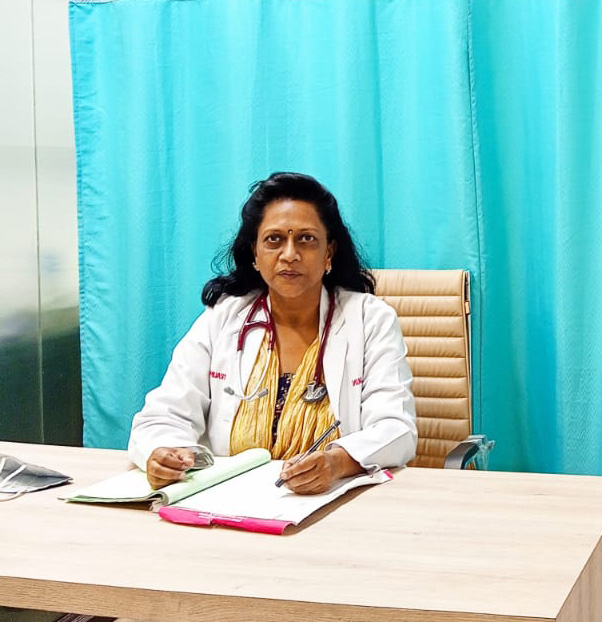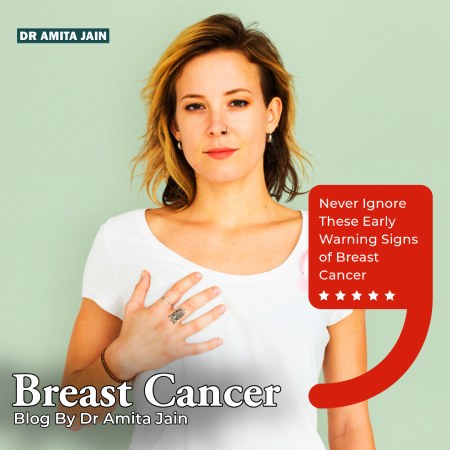Suggests Dr Amita Jain, India’s Top Surgeon for Breasts
In the pursuit of a happy and healthy life, we often come face to face with challenges that we cannot control. One such challenge is cancer, a relentless and deadly disease that can affect anyone, regardless of age, gender, or lifestyle. Breast cancer, in particular, is a formidable adversary that requires early detection for effective treatment. It affects both women and men, although it is more commonly diagnosed in women.
So, read more about the early warning signs of this condition as explained by Dr Amita Jain.
What are the probable signs of warning for breast cancer?
Dr. Jain says early monitoring could become life-saving. Thus, you must look for any of the following changes as mentioned below:
1. A palpable breast lump
The most common early sign of breast cancer is the formation of a painless lump that might have varying textures, such as soft and rubbery or hard. These lumps often develop in your upper, outer quadrant of the breast, extending into the armpit. However, it’s crucial to emphasize that not all breast lumps are cancerous; many are benign cysts or fibroadenomas. Any new or unusual breast lump needs to be promptly evaluated by a doctor to rule out any potential concerns.
2. Alteration in Breast shape and size
Keep an eye out for any unexplained changes in breast size or shape. This can include one breast becoming larger or noticeably different from the other.
The change happens due to menopause, which causes the breast to lose fat and become smaller and tender, while post-menopause may lead to increased fatty tissue. Hormone medications for menopause or birth control can also alter breast shape.
3. Nipple Changes
Changes in the nipple can be indicative of breast cancer. These changes might include:
Nipple Retraction or Inversion: In some cases of breast cancer, the tumor can pull the tissue inward, causing the nipple to retract or become inverted. It means the nipple, which normally, points outward, seems to be pulled inward or flattened.
Nipple Discharge:
Nipple discharge can result from various benign factors such as hormonal fluctuations, infections, fibrocystic breast changes, and benign tumors. During pregnancy and breastfeeding, milky discharge is common. However, if sudden discharge happens from one duct on a side without any link to pregnancy or breastfeeding, it could be a sign of potential issues such as cancer or DCIS (Ductal carcinoma in situ), the initial form of breast cancer. It’s important to be vigilant if the discharge is bloody or clear without any sort of manipulation.
Skin Changes: Breast cancer can affect the skin around the nipple and areola. Peeling, scaling, crusting, or flaking of the pigmented area of skin surrounding the nipple (areola) or breast skin can be noticed. You might notice dimpling, puckering, or skin thickening (resembling an orange peel) around the nipple. This is often due to the cancer affecting the ducts or glands beneath the nipple.
4. Swelling (edema) of the breast skin could be one of the early warning signs of inflammatory Breast Cancer. However, once again it may not always be cancerous.
5. Enlarged lymph nodes beneath the arm or surrounding the collarbone should not be ignored at all.
When breast cancer is diagnosed at an early stage, the probability of successful treatment and survival drastically increases. Regular self-breast examinations and mammograms are some of the key tools for detecting breast cancer in its early, more treatable stages.
Breast Self-examination (BSE) once a month needs to be conducted by women, especially for those with a genetic predisposition.
Mammograms, which involve low-dose X-rays of the breast, are the most reliable and effective way of detecting breast tumors well before they produce symptoms and while they are more manageable. Mammograms primarily focus on identifying the smaller tumors that aren’t yet detectable by touch or sight. Mammograms can be done post 40 years of age for those not at risk, but at 30 for those at risk.
Awareness empowers us. Raising awareness about breast cancer and its early signs is crucial to reducing its impact on lives.

Dr Amita Jain is a surgeon with the highest degree of professional competence, precision and surgical craftsmanship. Performed all complicated general surgery procedures with in depth knowledge of invasive and few minimal invasive and onco surgical techniques. Underwent special training in trauma, executed various trauma-related complex life-saving neurosurgical procedures, reconstructed injured mangled limbs and performed vascular and reconstructive procedures with critical care.
Dr Amita Jain holds 28 plus years of rich experience in Trauma and General Laparoscopic Surgeries (including Gallbladder stone removal, appendix removal, hernia repair surgery, piles and fissure surgeries). She was the Professor Surgery of at the Army College of Medical Sciences and Base Hospital Delhi Cantt. In 1994 she was commissioned as Surgeon under the United Nations Mission in Congo. From 2020 to 2022, she worked with Bansals Hospital. Currently, Dr Amita Jain is the Senior Consultant, (Speciality: General and Laparoscopic Surgeon) at Artemis Lite Hospital, New Delhi and Sr. General and Laparoscopic Surgeon at Rainbow Children Hospitals, Malviya Nagar, Delhi.
